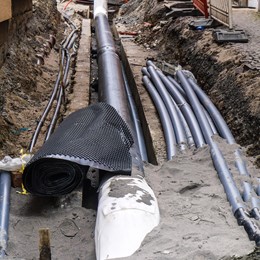Specialist Corporate and Commercial Lawyers
Table of Contents
Easements just got more complicated. The recent decision of the Land and Environment Court in CKDI Pty Ltd as trustee for CKDI Unit Trust v Ku-ring-gai Council (2023) NSWLEC 1018 means that applicants of a development application must obtain owner’s consent from any adjoining landowner over whose land an easement is proposed prior to Council determining the application, rather than relying on a deferred commencement condition.
Often, developers of land will, as part of their project, require an easement over an adjoining parcel of land. A significant part of our practice involves advising those developers who are seeking an easement, or advising a landowner who has been requested to consent to an easement over their land, and attempting to negotiate (or reject) the terms of the easement.
A common practice among Council’s over the years has been to make the registration of an easement (predominantly for stormwater) over adjoining land subject to a “deferred commencement” condition. This means that the Council would approve the development, subject to the satisfaction of the deferred commencement condition within a period of time (not exceeding the statutory maximum period of 5 years). The condition would usually be that the easement must be approved and registered within that time frame. Only when Council was satisfied that the easement was registered would the actual development consent become “operative” and be able to be acted upon.
This would allow the development application to be approved, and then negotiations entered into between the developer and the landowner for the specific terms of the easement, the works to be carried out under the easement and the compensation payable.
One of the basic requirements for lodging a development application is that “owner’s consent” to the application is given, in circumstances where an entity, other than the landowner, was lodging the development application. It is one of the formal checklist requirements in lodging an application. “Owner’s consent” could technically be provided at any time before the development application was determined. If no proper owners’ consent had been obtained, then it leaves any consent granted open to judicial review and a declaration of invalidity.
Earlier this year, the Land and Environment Court in CKDI Pty Ltd as trustee for CKDI Unit Trust v Ku-ring-gai Council (2023) NSWLEC, complicated things somewhat in relation to easements and owner’s consent. In that case, the developer, CKDI Pty Ltd, lodged a development application for works at 8 Woonoona Avenue, Wahroonga. The development application proposed a stormwater management plan that nominated stormwater discharge over adjoining parcels of land. Owner’s consent from those adjoining parcels of land was not given as part of the development application.
CKDI Pty Ltd argued that a deferred commencement condition requiring them to obtain registration of the easement was appropriate. Ku-ring-gai Council argued that it was precluded from granting consent to the development as the development sought works over a parcel of land which it did not hold owner’s consent for.
The Court held that as the easement drainage works formed part of the development the subject of the application, then formal owner’s consent is also required from the property (or properties) that would be the subject of an easement. That consent is required before Council has jurisdiction to approve a development consent.
This decision has changed the way both developers and landowners adjoining development sites should approach the granting of an easement required for development.
Developers should commence negotiating with adjoining landowners as early as possible, to ensure that they are not beholden to Council’s timetables once the development application has been lodged.
Adjoining landowners should not give formal “owner’s consent” to the development application until the negotiations for the easement have been finalised and documented in writing. This is to ensure that a landowner’s defence to any proceedings bought by the developer for enforcement of an easement are not prejudiced if negotiations break down and owner’s consent has been given prior to agreement being reached.
This article was co-written by Koreen Partridge, Senior Associate.
This article is not legal advice. It is intended to provide commentary and general information only. Access to this article does not entitle you to rely on it as legal advice. You should obtain formal legal advice specific to your own situation. Please contact us if you require advice on matters covered by this article.
